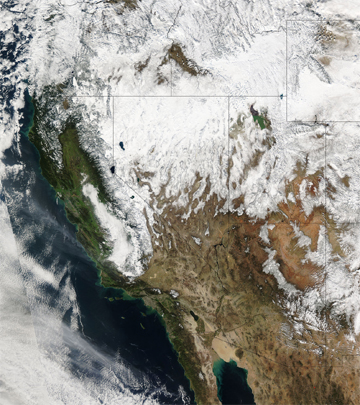
 Over the course
of three weeks in late December and early January, a series of storms battered
California, Utah, Nevada and Arizona, bringing heavy snowfall in the mountains
and torrential rainfall that triggered deadly flooding and mudslides. The bizarre
weather was caused by a confluence of systems, one from the frigid north and one
from the tropics, made possible by a little known climate cycle.
Over the course
of three weeks in late December and early January, a series of storms battered
California, Utah, Nevada and Arizona, bringing heavy snowfall in the mountains
and torrential rainfall that triggered deadly flooding and mudslides. The bizarre
weather was caused by a confluence of systems, one from the frigid north and one
from the tropics, made possible by a little known climate cycle.The weather “was quite unusual,” says Dan Keeton, meteorologist in
charge of the Los Angeles bureau of the National Weather Service, “perhaps
even freakish.” Almost 20 feet of snow fell in the Sierra Nevada, and southern
California had more rain than it had seen in any of the past 40 years. In the
first 10 days of January, Los Angeles accumulated 15 inches of rain — more
than the yearly average.
The weather events were responsible for the deaths of 28 people in California
and have cost the state an estimated $100 million. Ten of the victims were killed
when a rain-saturated hillside collapsed, burying a La Conchita neighborhood
under 30 feet of mud that destroyed 13 homes and damaged 18 others. The disaster
prompted Gov. Arnold Schwarzenegger to declare a countywide state of emergency.
A 1995 landslide in La Conchita, about 60 miles northwest of Los Angeles, damaged
14 houses but caused no deaths.
The storms began to brew in late December, when a subtropical moisture-laden
jet stream, called the Pineapple Express, made its way north out of the Pacific
where it had soaked up massive amounts of warm water. At the same time, a cold
front was moving icy air down the West Coast. When they collided, “the
cold air tapped into this subtropical moisture,” Keeton says. “That’s
what made the storms so devastatingly wet in our area.”
The Pineapple Express was made possible by the Madden-Julian climate oscillation,
a rearrangement of the atmosphere that operates on a 30- to 60-day cycle. Named
for its discoverers Roland Madden and Paul Julian, who, in 1971, were the first
to discern the relationship between heat being emitted from the atmosphere and
changes in zonal winds above the tropical Pacific, the oscillation accounts
for a large degree of the weather variation in the tropics, something previously
thought to be unpredictable.
While such weather systems themselves are routine, Keeton says that what made
late December and early January distinctive was the back-to-back arrival of
several intense storms, resulting in four separate outbursts of heavy rain.
“One or two would be remarkable in themselves,” he says, “but
taken together they became phenomenal.”
The winter storms followed close on the track of several large storms last fall
that also delivered record rain and snowfall to many parts of the West. The
Sierra Nevada had already recorded 48 inches of snow in October, when a Thanksgiving
storm dropped another 18 inches.
The substantial snowpack may prove a boon for much of the western United States,
which has been mired in a five-year-long drought. According to the National
Oceanic and Atmospheric Administration’s Climate Prediction Center, in
January, the water content of the snowpack in the Southwest was 150 percent
of normal.
In some of the West, however, especially southern California, where much of
the precipitation drained off the saturated surface soils and back into the
ocean, Keeton notes that “drought is a multi-year problem — just one
wet season won’t solve it.”
Sara Pratt
Geotimes contributing writer
 |
Geotimes Home | AGI Home | Information Services | Geoscience Education | Public Policy | Programs | Publications | Careers |